Unit 29: Healthcare Strategies for Promoting Positive Behaviour
VerifiedAdded on 2020/10/04
|9
|1660
|122
Report
AI Summary
This report delves into the critical aspects of promoting positive behaviour within the Health and Social Care (HSC) sector. It begins by exploring relevant legislations concerning restrictive interventions, and then outlines various interventions used to foster positive behaviours, including the implementation of behaviour plans and proactive strategies. The report emphasizes the importance of person-centered approaches and the differences between proactive and reactive strategies. It further examines best practices, types of challenging behaviours, and steps to maintain dignity and respect for individuals. Finally, the report describes methods for checking on an individual's well-being, concluding that the promotion of positive behaviour is essential for systematic and effective results within the HSC environment. The report references various books and journals to support the concepts discussed.
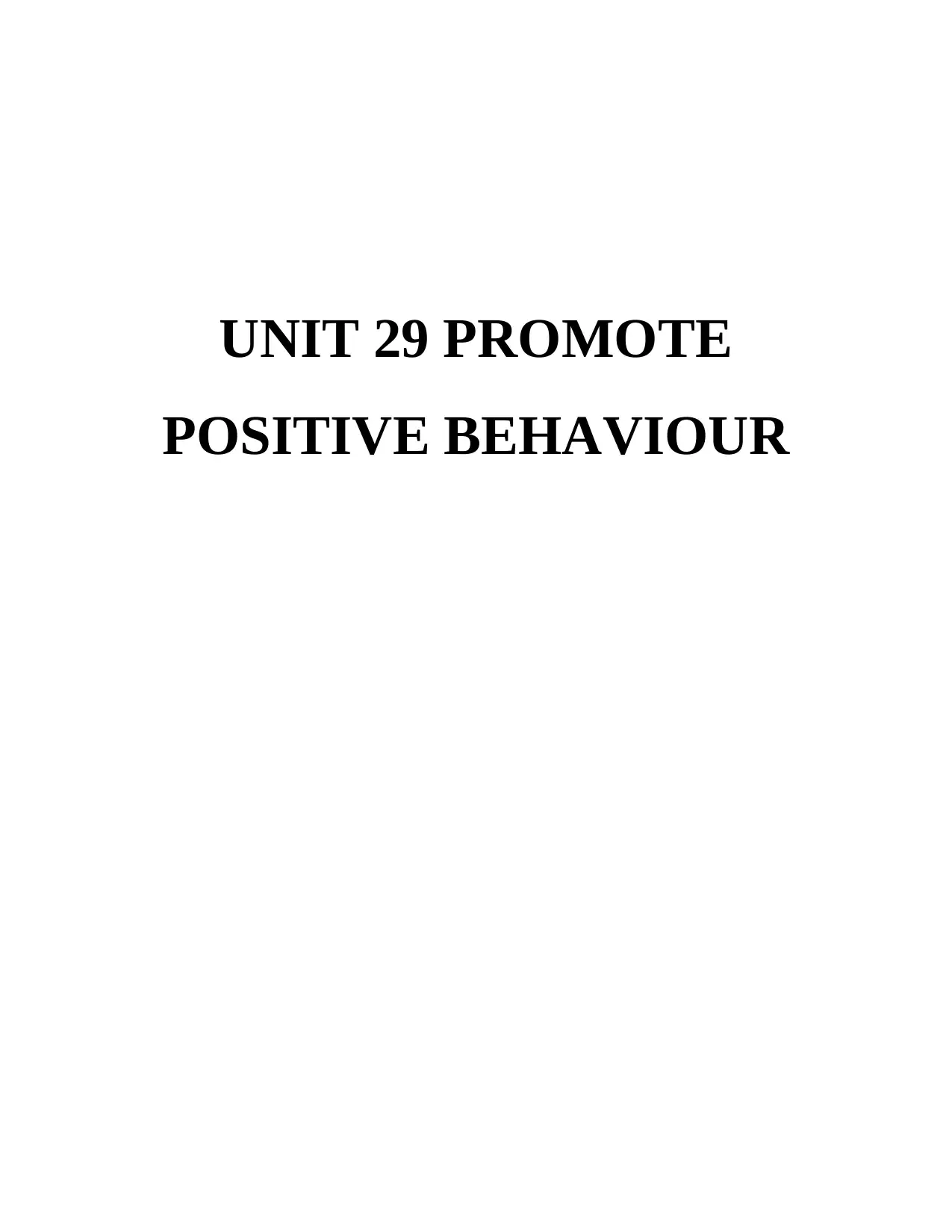
UNIT 29 PROMOTE
POSITIVE BEHAVIOUR
POSITIVE BEHAVIOUR
Paraphrase This Document
Need a fresh take? Get an instant paraphrase of this document with our AI Paraphraser
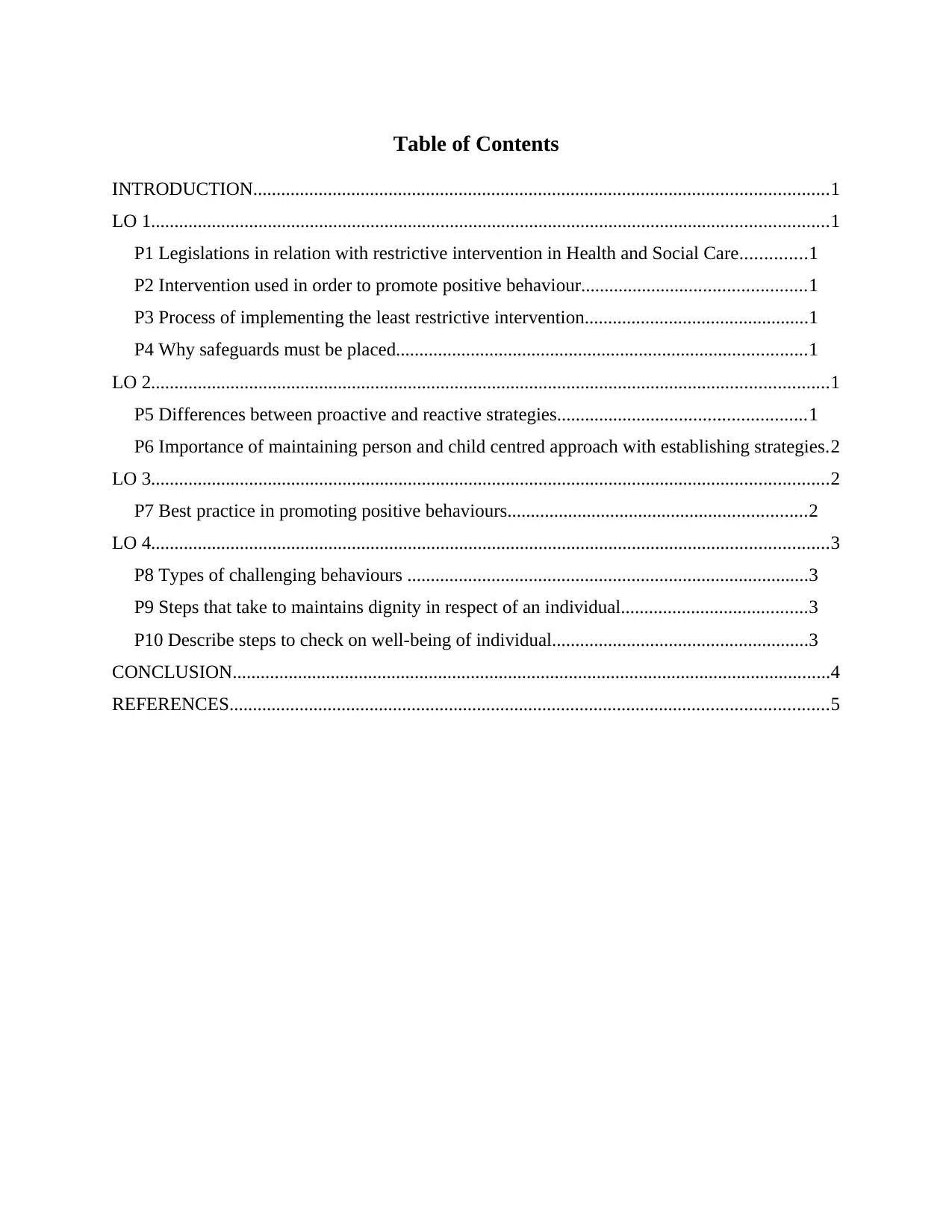
Table of Contents
INTRODUCTION...........................................................................................................................1
LO 1.................................................................................................................................................1
P1 Legislations in relation with restrictive intervention in Health and Social Care..............1
P2 Intervention used in order to promote positive behaviour................................................1
P3 Process of implementing the least restrictive intervention................................................1
P4 Why safeguards must be placed........................................................................................1
LO 2.................................................................................................................................................1
P5 Differences between proactive and reactive strategies.....................................................1
P6 Importance of maintaining person and child centred approach with establishing strategies.2
LO 3.................................................................................................................................................2
P7 Best practice in promoting positive behaviours................................................................2
LO 4.................................................................................................................................................3
P8 Types of challenging behaviours ......................................................................................3
P9 Steps that take to maintains dignity in respect of an individual........................................3
P10 Describe steps to check on well-being of individual.......................................................3
CONCLUSION................................................................................................................................4
REFERENCES................................................................................................................................5
INTRODUCTION...........................................................................................................................1
LO 1.................................................................................................................................................1
P1 Legislations in relation with restrictive intervention in Health and Social Care..............1
P2 Intervention used in order to promote positive behaviour................................................1
P3 Process of implementing the least restrictive intervention................................................1
P4 Why safeguards must be placed........................................................................................1
LO 2.................................................................................................................................................1
P5 Differences between proactive and reactive strategies.....................................................1
P6 Importance of maintaining person and child centred approach with establishing strategies.2
LO 3.................................................................................................................................................2
P7 Best practice in promoting positive behaviours................................................................2
LO 4.................................................................................................................................................3
P8 Types of challenging behaviours ......................................................................................3
P9 Steps that take to maintains dignity in respect of an individual........................................3
P10 Describe steps to check on well-being of individual.......................................................3
CONCLUSION................................................................................................................................4
REFERENCES................................................................................................................................5

⊘ This is a preview!⊘
Do you want full access?
Subscribe today to unlock all pages.

Trusted by 1+ million students worldwide
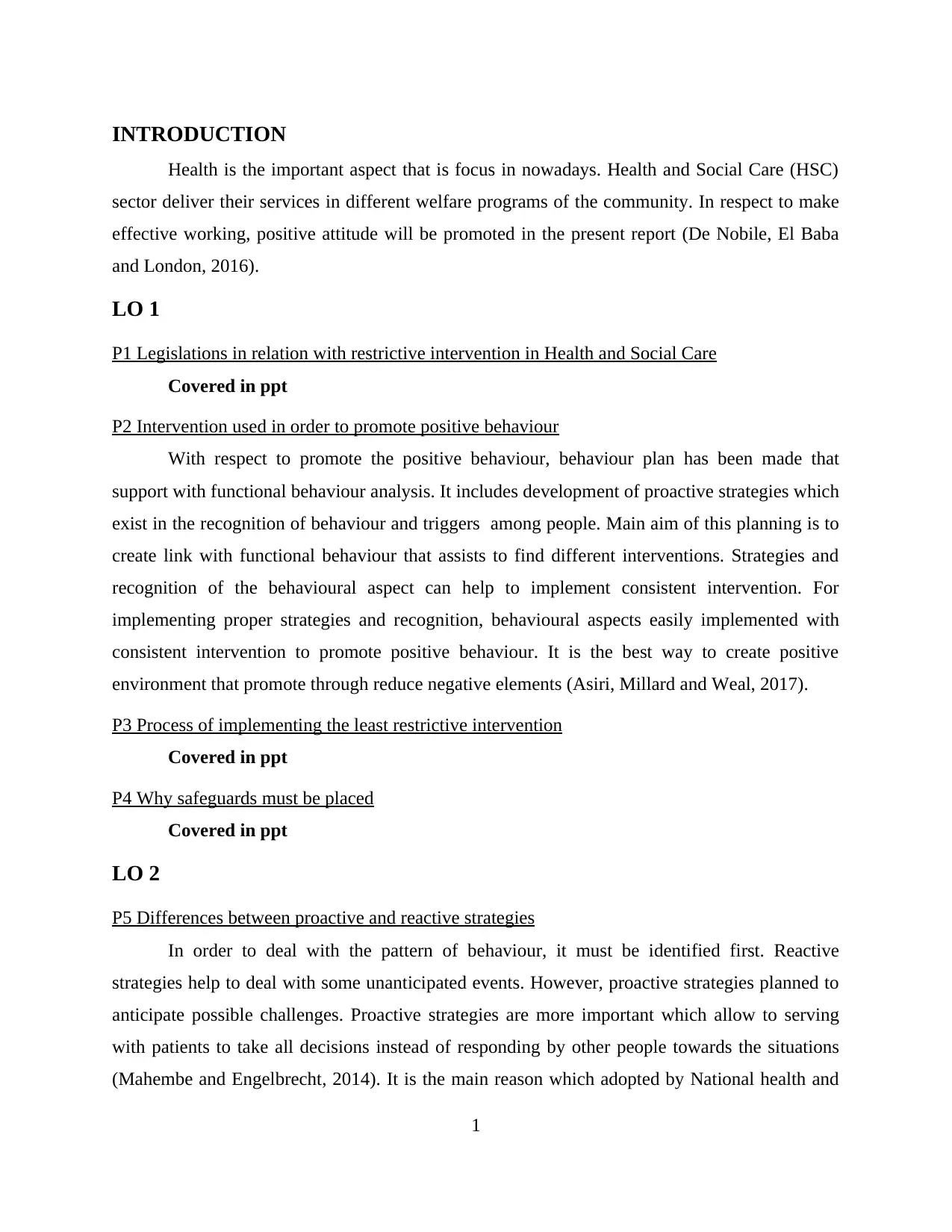
INTRODUCTION
Health is the important aspect that is focus in nowadays. Health and Social Care (HSC)
sector deliver their services in different welfare programs of the community. In respect to make
effective working, positive attitude will be promoted in the present report (De Nobile, El Baba
and London, 2016).
LO 1
P1 Legislations in relation with restrictive intervention in Health and Social Care
Covered in ppt
P2 Intervention used in order to promote positive behaviour
With respect to promote the positive behaviour, behaviour plan has been made that
support with functional behaviour analysis. It includes development of proactive strategies which
exist in the recognition of behaviour and triggers among people. Main aim of this planning is to
create link with functional behaviour that assists to find different interventions. Strategies and
recognition of the behavioural aspect can help to implement consistent intervention. For
implementing proper strategies and recognition, behavioural aspects easily implemented with
consistent intervention to promote positive behaviour. It is the best way to create positive
environment that promote through reduce negative elements (Asiri, Millard and Weal, 2017).
P3 Process of implementing the least restrictive intervention
Covered in ppt
P4 Why safeguards must be placed
Covered in ppt
LO 2
P5 Differences between proactive and reactive strategies
In order to deal with the pattern of behaviour, it must be identified first. Reactive
strategies help to deal with some unanticipated events. However, proactive strategies planned to
anticipate possible challenges. Proactive strategies are more important which allow to serving
with patients to take all decisions instead of responding by other people towards the situations
(Mahembe and Engelbrecht, 2014). It is the main reason which adopted by National health and
1
Health is the important aspect that is focus in nowadays. Health and Social Care (HSC)
sector deliver their services in different welfare programs of the community. In respect to make
effective working, positive attitude will be promoted in the present report (De Nobile, El Baba
and London, 2016).
LO 1
P1 Legislations in relation with restrictive intervention in Health and Social Care
Covered in ppt
P2 Intervention used in order to promote positive behaviour
With respect to promote the positive behaviour, behaviour plan has been made that
support with functional behaviour analysis. It includes development of proactive strategies which
exist in the recognition of behaviour and triggers among people. Main aim of this planning is to
create link with functional behaviour that assists to find different interventions. Strategies and
recognition of the behavioural aspect can help to implement consistent intervention. For
implementing proper strategies and recognition, behavioural aspects easily implemented with
consistent intervention to promote positive behaviour. It is the best way to create positive
environment that promote through reduce negative elements (Asiri, Millard and Weal, 2017).
P3 Process of implementing the least restrictive intervention
Covered in ppt
P4 Why safeguards must be placed
Covered in ppt
LO 2
P5 Differences between proactive and reactive strategies
In order to deal with the pattern of behaviour, it must be identified first. Reactive
strategies help to deal with some unanticipated events. However, proactive strategies planned to
anticipate possible challenges. Proactive strategies are more important which allow to serving
with patients to take all decisions instead of responding by other people towards the situations
(Mahembe and Engelbrecht, 2014). It is the main reason which adopted by National health and
1
Paraphrase This Document
Need a fresh take? Get an instant paraphrase of this document with our AI Paraphraser
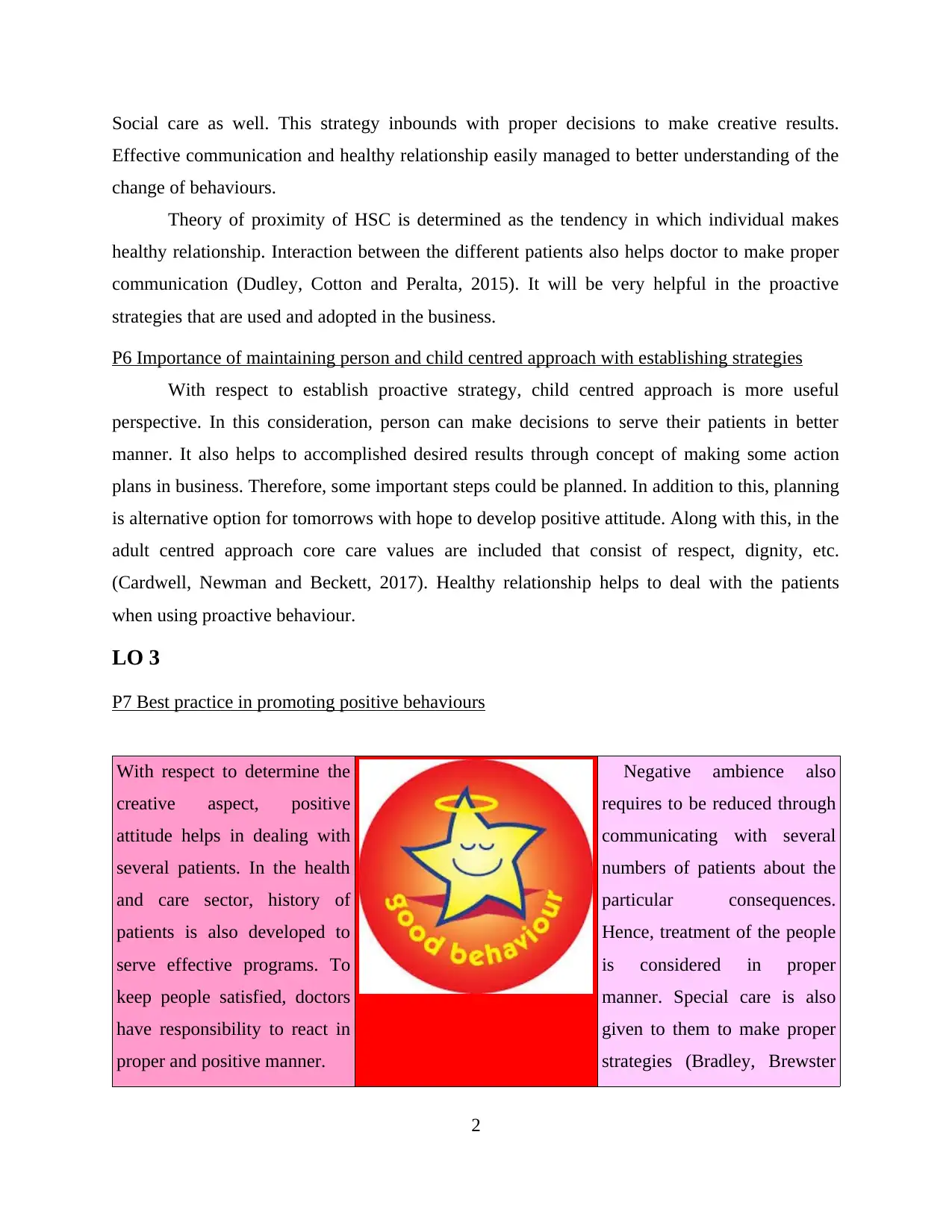
Social care as well. This strategy inbounds with proper decisions to make creative results.
Effective communication and healthy relationship easily managed to better understanding of the
change of behaviours.
Theory of proximity of HSC is determined as the tendency in which individual makes
healthy relationship. Interaction between the different patients also helps doctor to make proper
communication (Dudley, Cotton and Peralta, 2015). It will be very helpful in the proactive
strategies that are used and adopted in the business.
P6 Importance of maintaining person and child centred approach with establishing strategies
With respect to establish proactive strategy, child centred approach is more useful
perspective. In this consideration, person can make decisions to serve their patients in better
manner. It also helps to accomplished desired results through concept of making some action
plans in business. Therefore, some important steps could be planned. In addition to this, planning
is alternative option for tomorrows with hope to develop positive attitude. Along with this, in the
adult centred approach core care values are included that consist of respect, dignity, etc.
(Cardwell, Newman and Beckett, 2017). Healthy relationship helps to deal with the patients
when using proactive behaviour.
LO 3
P7 Best practice in promoting positive behaviours
With respect to determine the
creative aspect, positive
attitude helps in dealing with
several patients. In the health
and care sector, history of
patients is also developed to
serve effective programs. To
keep people satisfied, doctors
have responsibility to react in
proper and positive manner.
Negative ambience also
requires to be reduced through
communicating with several
numbers of patients about the
particular consequences.
Hence, treatment of the people
is considered in proper
manner. Special care is also
given to them to make proper
strategies (Bradley, Brewster
2
Effective communication and healthy relationship easily managed to better understanding of the
change of behaviours.
Theory of proximity of HSC is determined as the tendency in which individual makes
healthy relationship. Interaction between the different patients also helps doctor to make proper
communication (Dudley, Cotton and Peralta, 2015). It will be very helpful in the proactive
strategies that are used and adopted in the business.
P6 Importance of maintaining person and child centred approach with establishing strategies
With respect to establish proactive strategy, child centred approach is more useful
perspective. In this consideration, person can make decisions to serve their patients in better
manner. It also helps to accomplished desired results through concept of making some action
plans in business. Therefore, some important steps could be planned. In addition to this, planning
is alternative option for tomorrows with hope to develop positive attitude. Along with this, in the
adult centred approach core care values are included that consist of respect, dignity, etc.
(Cardwell, Newman and Beckett, 2017). Healthy relationship helps to deal with the patients
when using proactive behaviour.
LO 3
P7 Best practice in promoting positive behaviours
With respect to determine the
creative aspect, positive
attitude helps in dealing with
several patients. In the health
and care sector, history of
patients is also developed to
serve effective programs. To
keep people satisfied, doctors
have responsibility to react in
proper and positive manner.
Negative ambience also
requires to be reduced through
communicating with several
numbers of patients about the
particular consequences.
Hence, treatment of the people
is considered in proper
manner. Special care is also
given to them to make proper
strategies (Bradley, Brewster
2
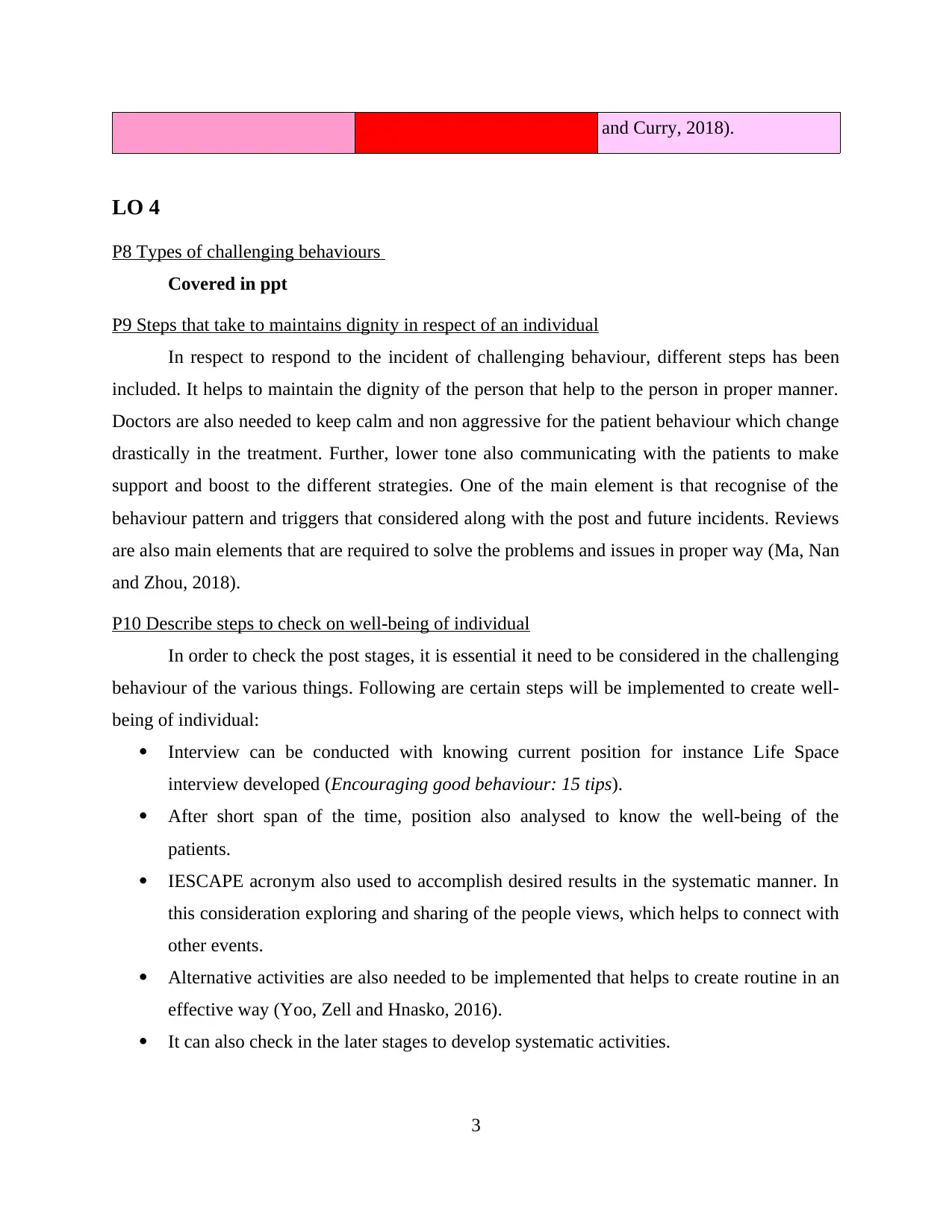
and Curry, 2018).
LO 4
P8 Types of challenging behaviours
Covered in ppt
P9 Steps that take to maintains dignity in respect of an individual
In respect to respond to the incident of challenging behaviour, different steps has been
included. It helps to maintain the dignity of the person that help to the person in proper manner.
Doctors are also needed to keep calm and non aggressive for the patient behaviour which change
drastically in the treatment. Further, lower tone also communicating with the patients to make
support and boost to the different strategies. One of the main element is that recognise of the
behaviour pattern and triggers that considered along with the post and future incidents. Reviews
are also main elements that are required to solve the problems and issues in proper way (Ma, Nan
and Zhou, 2018).
P10 Describe steps to check on well-being of individual
In order to check the post stages, it is essential it need to be considered in the challenging
behaviour of the various things. Following are certain steps will be implemented to create well-
being of individual:
Interview can be conducted with knowing current position for instance Life Space
interview developed (Encouraging good behaviour: 15 tips).
After short span of the time, position also analysed to know the well-being of the
patients.
IESCAPE acronym also used to accomplish desired results in the systematic manner. In
this consideration exploring and sharing of the people views, which helps to connect with
other events.
Alternative activities are also needed to be implemented that helps to create routine in an
effective way (Yoo, Zell and Hnasko, 2016).
It can also check in the later stages to develop systematic activities.
3
LO 4
P8 Types of challenging behaviours
Covered in ppt
P9 Steps that take to maintains dignity in respect of an individual
In respect to respond to the incident of challenging behaviour, different steps has been
included. It helps to maintain the dignity of the person that help to the person in proper manner.
Doctors are also needed to keep calm and non aggressive for the patient behaviour which change
drastically in the treatment. Further, lower tone also communicating with the patients to make
support and boost to the different strategies. One of the main element is that recognise of the
behaviour pattern and triggers that considered along with the post and future incidents. Reviews
are also main elements that are required to solve the problems and issues in proper way (Ma, Nan
and Zhou, 2018).
P10 Describe steps to check on well-being of individual
In order to check the post stages, it is essential it need to be considered in the challenging
behaviour of the various things. Following are certain steps will be implemented to create well-
being of individual:
Interview can be conducted with knowing current position for instance Life Space
interview developed (Encouraging good behaviour: 15 tips).
After short span of the time, position also analysed to know the well-being of the
patients.
IESCAPE acronym also used to accomplish desired results in the systematic manner. In
this consideration exploring and sharing of the people views, which helps to connect with
other events.
Alternative activities are also needed to be implemented that helps to create routine in an
effective way (Yoo, Zell and Hnasko, 2016).
It can also check in the later stages to develop systematic activities.
3
⊘ This is a preview!⊘
Do you want full access?
Subscribe today to unlock all pages.

Trusted by 1+ million students worldwide
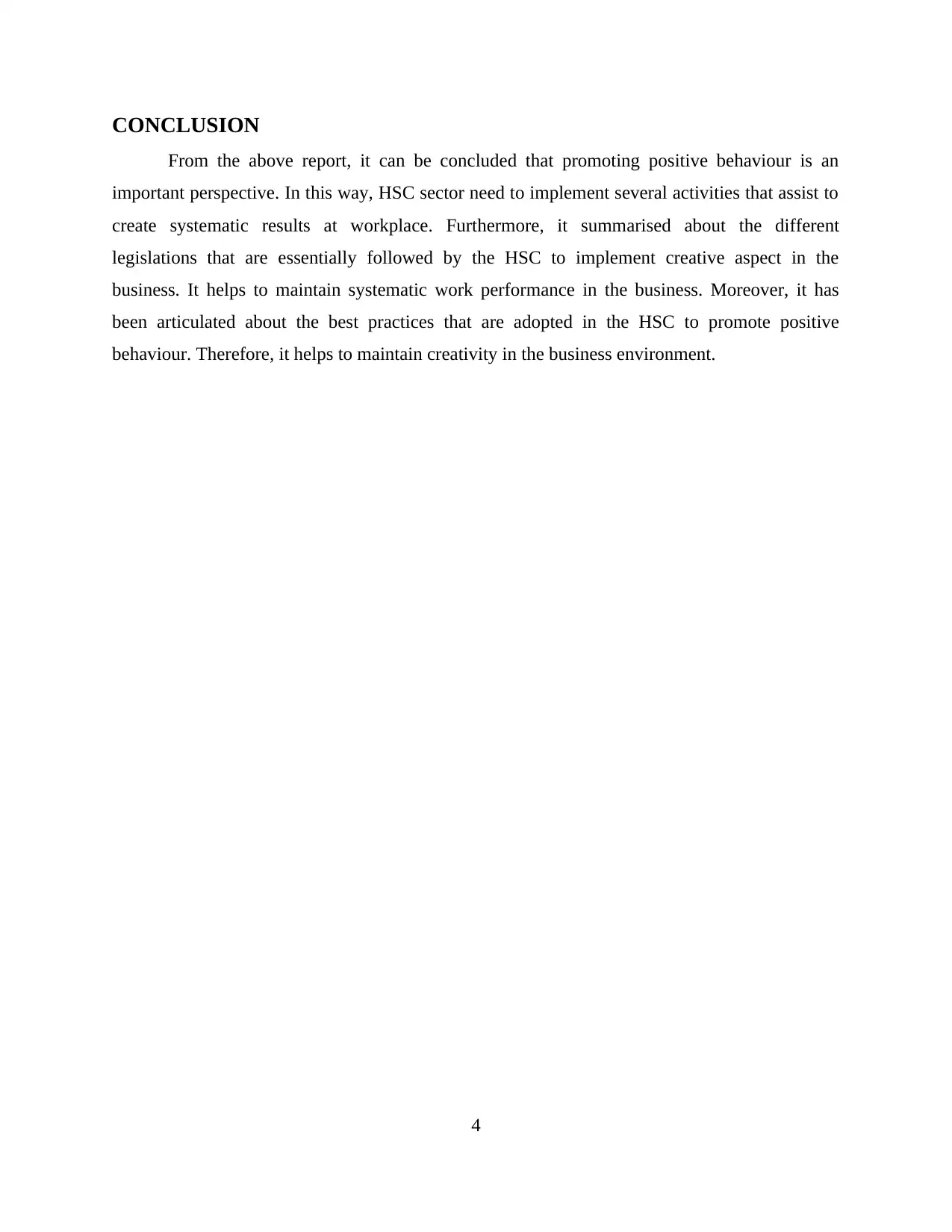
CONCLUSION
From the above report, it can be concluded that promoting positive behaviour is an
important perspective. In this way, HSC sector need to implement several activities that assist to
create systematic results at workplace. Furthermore, it summarised about the different
legislations that are essentially followed by the HSC to implement creative aspect in the
business. It helps to maintain systematic work performance in the business. Moreover, it has
been articulated about the best practices that are adopted in the HSC to promote positive
behaviour. Therefore, it helps to maintain creativity in the business environment.
4
From the above report, it can be concluded that promoting positive behaviour is an
important perspective. In this way, HSC sector need to implement several activities that assist to
create systematic results at workplace. Furthermore, it summarised about the different
legislations that are essentially followed by the HSC to implement creative aspect in the
business. It helps to maintain systematic work performance in the business. Moreover, it has
been articulated about the best practices that are adopted in the HSC to promote positive
behaviour. Therefore, it helps to maintain creativity in the business environment.
4
Paraphrase This Document
Need a fresh take? Get an instant paraphrase of this document with our AI Paraphraser
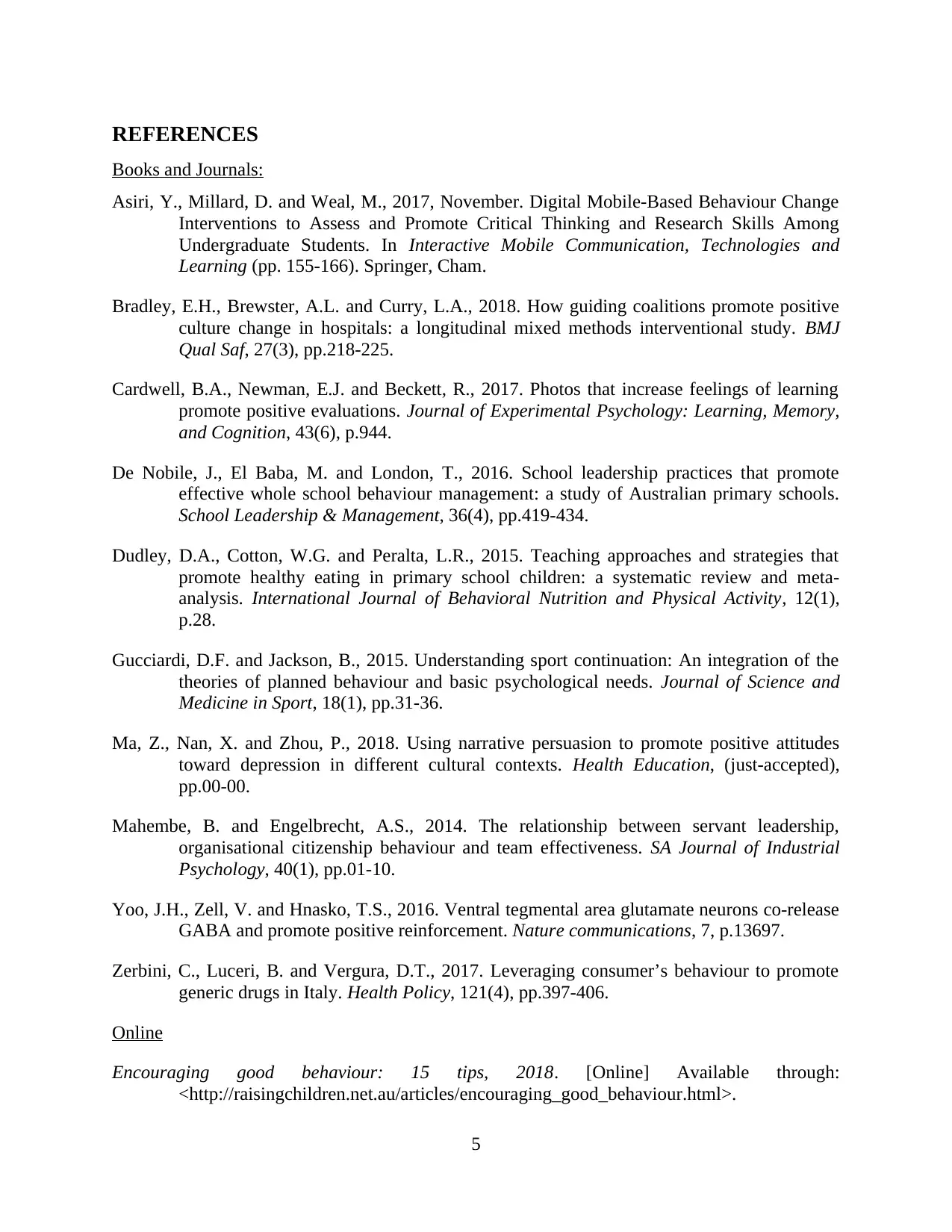
REFERENCES
Books and Journals:
Asiri, Y., Millard, D. and Weal, M., 2017, November. Digital Mobile-Based Behaviour Change
Interventions to Assess and Promote Critical Thinking and Research Skills Among
Undergraduate Students. In Interactive Mobile Communication, Technologies and
Learning (pp. 155-166). Springer, Cham.
Bradley, E.H., Brewster, A.L. and Curry, L.A., 2018. How guiding coalitions promote positive
culture change in hospitals: a longitudinal mixed methods interventional study. BMJ
Qual Saf, 27(3), pp.218-225.
Cardwell, B.A., Newman, E.J. and Beckett, R., 2017. Photos that increase feelings of learning
promote positive evaluations. Journal of Experimental Psychology: Learning, Memory,
and Cognition, 43(6), p.944.
De Nobile, J., El Baba, M. and London, T., 2016. School leadership practices that promote
effective whole school behaviour management: a study of Australian primary schools.
School Leadership & Management, 36(4), pp.419-434.
Dudley, D.A., Cotton, W.G. and Peralta, L.R., 2015. Teaching approaches and strategies that
promote healthy eating in primary school children: a systematic review and meta-
analysis. International Journal of Behavioral Nutrition and Physical Activity, 12(1),
p.28.
Gucciardi, D.F. and Jackson, B., 2015. Understanding sport continuation: An integration of the
theories of planned behaviour and basic psychological needs. Journal of Science and
Medicine in Sport, 18(1), pp.31-36.
Ma, Z., Nan, X. and Zhou, P., 2018. Using narrative persuasion to promote positive attitudes
toward depression in different cultural contexts. Health Education, (just-accepted),
pp.00-00.
Mahembe, B. and Engelbrecht, A.S., 2014. The relationship between servant leadership,
organisational citizenship behaviour and team effectiveness. SA Journal of Industrial
Psychology, 40(1), pp.01-10.
Yoo, J.H., Zell, V. and Hnasko, T.S., 2016. Ventral tegmental area glutamate neurons co-release
GABA and promote positive reinforcement. Nature communications, 7, p.13697.
Zerbini, C., Luceri, B. and Vergura, D.T., 2017. Leveraging consumer’s behaviour to promote
generic drugs in Italy. Health Policy, 121(4), pp.397-406.
Online
Encouraging good behaviour: 15 tips, 2018. [Online] Available through:
<http://raisingchildren.net.au/articles/encouraging_good_behaviour.html>.
5
Books and Journals:
Asiri, Y., Millard, D. and Weal, M., 2017, November. Digital Mobile-Based Behaviour Change
Interventions to Assess and Promote Critical Thinking and Research Skills Among
Undergraduate Students. In Interactive Mobile Communication, Technologies and
Learning (pp. 155-166). Springer, Cham.
Bradley, E.H., Brewster, A.L. and Curry, L.A., 2018. How guiding coalitions promote positive
culture change in hospitals: a longitudinal mixed methods interventional study. BMJ
Qual Saf, 27(3), pp.218-225.
Cardwell, B.A., Newman, E.J. and Beckett, R., 2017. Photos that increase feelings of learning
promote positive evaluations. Journal of Experimental Psychology: Learning, Memory,
and Cognition, 43(6), p.944.
De Nobile, J., El Baba, M. and London, T., 2016. School leadership practices that promote
effective whole school behaviour management: a study of Australian primary schools.
School Leadership & Management, 36(4), pp.419-434.
Dudley, D.A., Cotton, W.G. and Peralta, L.R., 2015. Teaching approaches and strategies that
promote healthy eating in primary school children: a systematic review and meta-
analysis. International Journal of Behavioral Nutrition and Physical Activity, 12(1),
p.28.
Gucciardi, D.F. and Jackson, B., 2015. Understanding sport continuation: An integration of the
theories of planned behaviour and basic psychological needs. Journal of Science and
Medicine in Sport, 18(1), pp.31-36.
Ma, Z., Nan, X. and Zhou, P., 2018. Using narrative persuasion to promote positive attitudes
toward depression in different cultural contexts. Health Education, (just-accepted),
pp.00-00.
Mahembe, B. and Engelbrecht, A.S., 2014. The relationship between servant leadership,
organisational citizenship behaviour and team effectiveness. SA Journal of Industrial
Psychology, 40(1), pp.01-10.
Yoo, J.H., Zell, V. and Hnasko, T.S., 2016. Ventral tegmental area glutamate neurons co-release
GABA and promote positive reinforcement. Nature communications, 7, p.13697.
Zerbini, C., Luceri, B. and Vergura, D.T., 2017. Leveraging consumer’s behaviour to promote
generic drugs in Italy. Health Policy, 121(4), pp.397-406.
Online
Encouraging good behaviour: 15 tips, 2018. [Online] Available through:
<http://raisingchildren.net.au/articles/encouraging_good_behaviour.html>.
5

6
⊘ This is a preview!⊘
Do you want full access?
Subscribe today to unlock all pages.

Trusted by 1+ million students worldwide
1 out of 9
Related Documents
Your All-in-One AI-Powered Toolkit for Academic Success.
+13062052269
info@desklib.com
Available 24*7 on WhatsApp / Email
![[object Object]](/_next/static/media/star-bottom.7253800d.svg)
Unlock your academic potential
Copyright © 2020–2025 A2Z Services. All Rights Reserved. Developed and managed by ZUCOL.





